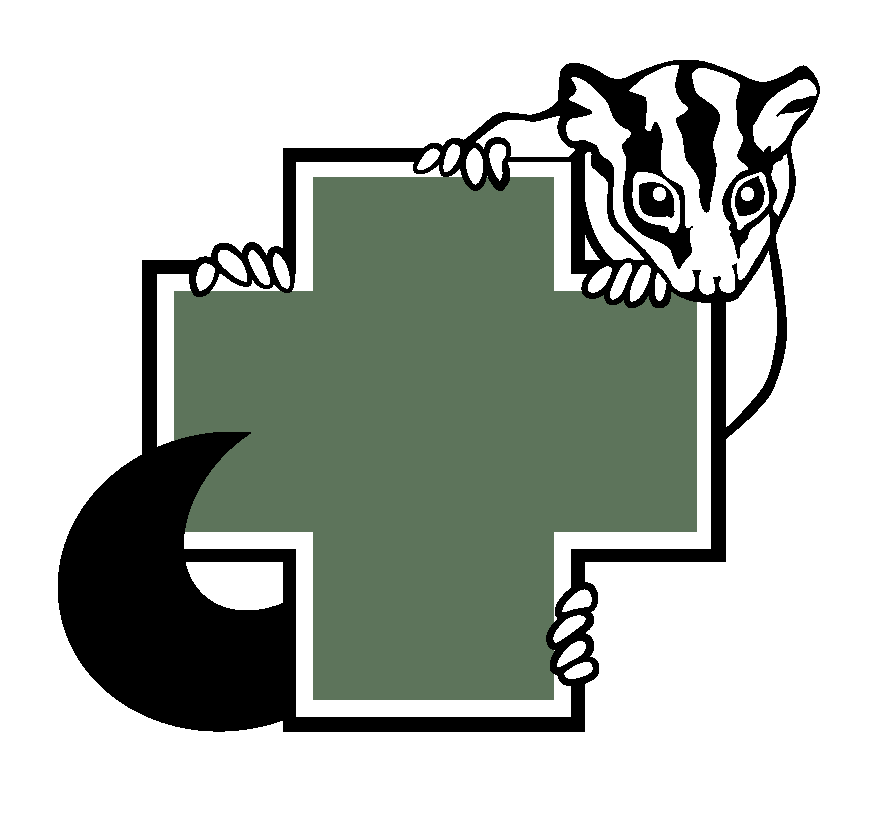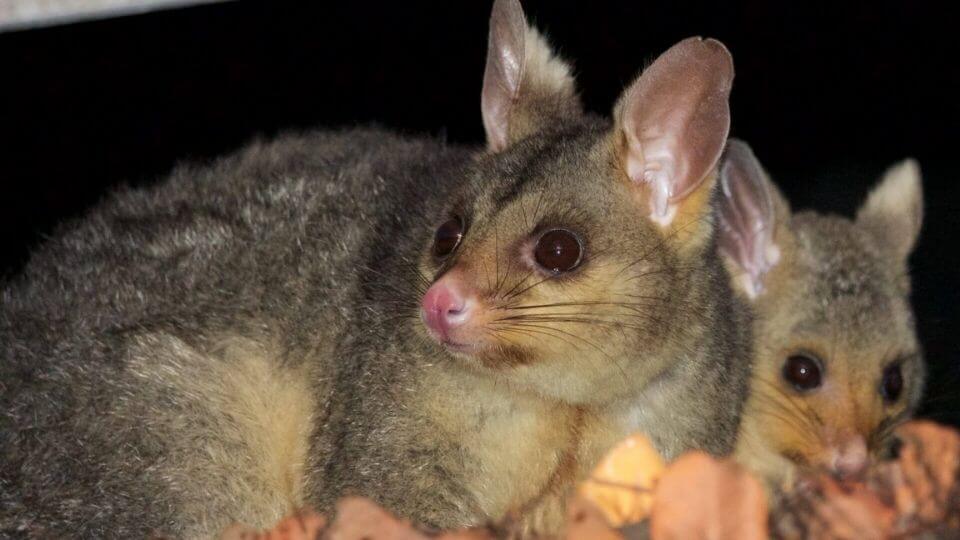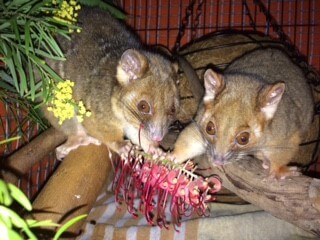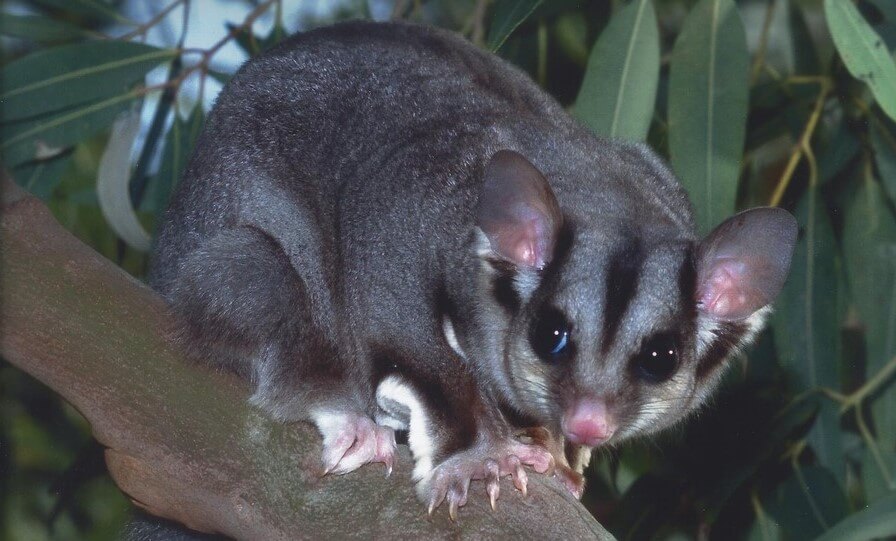RESCUE ADVICE
Possums & Gliders
Helping sick, injured and orphaned possums and gliders
Possums and gliders that are found on the ground and/or during the day must always be reported – they are nocturnal animals, and this is abnormal behaviour that is often due to sickness or rat bait poisoning.
Possums in particular are the Australian marsupial most often seen by city dwellers, as it is one of few that has to adapted to cities and human-modified environments. Around human habitations, common brushtails are inventive and determined foragers with a liking for fruit trees, vegetable gardens and even kitchen raids.
If you find an injured or sick possum or glider, please call our 24/7 Rescue Line on 0418 628 483.
It is operated by volunteers at WIRES. They will alert our team and a trained rescuer will be out as soon as possible.
Possums & Gliders In The Hunter
Common Ringtail (Pseudocheirus peregrinus) and Common Brushtail (Trichosurus vulpecula) possums are two of the most common species we rescue and rehabilitate. These species thrive in cities and a wide range of natural and human-modified environments as determined, opportunistic foragers.
Throughout the Hunter Valley, we are lucky enough to encounter several species of native glider; the most common of which are the feathertail glider (Acrobates pygmaeus), sugar glider (Petaurus breviceps) and squirrel glider (Petaurus norfolcensis).
Appearance
Brushtail possums are noticeably larger than their ringtail cousins — about the size of an adult cat, and can weigh up to 4kg. True to their name, they have a thick, bushy black tail that looks a bit like a bottlebrush. Their fur is usually grey with a pale underside, but you might occasionally spot a rare golden or yellow variation.
Distribution and Habitat
Brushtail possums are found throughout many parts of Australia and are incredibly adaptable. While they naturally live in forests and woodlands, they’re also commonly seen in urban areas — in backyards, gardens, and local parks.
Diet
These possums aren’t fussy eaters. Their diet includes leaves, flowers, fruits, insects, and bird eggs. In built-up areas, they may rummage through bins or compost, often nibbling on bread, cake, or other food scraps.
Behaviour
In the wild, brushtails would normally nest in tree hollows. But with land clearing reducing natural habitat, they’ve learned to make do — often moving into roofs, wall cavities, sheds, and even chimneys. They’re drawn to dark, enclosed spaces that feel similar to their natural homes.
Breeding Season
Breeding usually takes place from March to May. Female brushtails typically have one joey per season. The baby stays in mum’s pouch for up to six months, then rides on her back (known as a “backrider”) while continuing to grow and learn. Joeys stick close to their mothers for several months before becoming independent.
Appearance
Ringtail possums have a thin, white tipped tail that curls like a ring and acts like a fifth limb. They have brown, grey or reddish fur on their head and back, with lighter fur on their chests. Ringtails are smaller than brushtails, weighing less than 1kg and visually about the size of a young kitten.
Distribution and habitat
Ringtail possums are found across Australia and have adapted well to a range of habitats. They are often spotted in suburbs and backyards.
Diet
The ringtail possum’s diet consists mainly of eucalyptus leaves and other native vegetation, but they also consume flowers and fruits. Ringtails consume their excrement to obtain the maximum amount of nutrients possible. This is known as caecotrophy.
Behaviour
One of the biggest differences between brushtails and ringtails is their nest. While brushtails prefer hollows of trees, ringtails make their own nest called a drey. Dreys are made up of grass, twigs and leaves woven together to make a round sphere. Both species are known to reside in roofs and ceilings, especially in suburban areas where resources might be limited.
Breeding season
Breeding season is from April to November, with adult females producing one to three young – called joeys. Joeys are born hairless and weigh less than one gram. They spend five to six months developing in the mother’s pouch before coming out. Once they start to emerge, they spend a lot of time clinging to their mother’s back and being carried around. They spend several more months with their mother before venturing off on their own. As ringtails have multiple young, it isn’t uncommon for a joey that has fallen off their mother’s back to be left behind.
Appearance
Sugar Gliders are small, agile marsupials about the size of a rat. They have grey fur with a distinctive black dorsal stripe, large forward-facing eyes, and a gliding membrane that stretches from wrist to ankle.
Distribution and habitat
Found in forests and woodlands across the Hunter region, Sugar Gliders rely on mature trees with hollows for shelter and nesting. They’re often seen in eucalyptus or acacia-dominated habitats.
Diet
Their diet includes sap and gum from trees, nectar, pollen, insects, and small invertebrates. They are particularly fond of sugary substances, hence their name.
Behaviour
These gliders are social and live in small family groups. They are nocturnal and use their gliding membrane to travel between trees—sometimes covering distances of up to 50 metres. Their calls range from soft chirps to loud barks or squeals.
Breeding season
Sugar Gliders usually breed between June and November. Females give birth to one or two joeys, which stay in the pouch for about 2 months before transitioning to a nest.
Appearance
Slightly larger than Sugar Gliders, Squirrel Gliders have a similar build but with a bushier tail and thicker body. Their fur is soft and grey with a black stripe running from nose to mid-back.
Distribution and habitat
In the Hunter region, Squirrel Gliders inhabit open forests, particularly areas with flowering eucalypts, wattles, and abundant tree hollows. They require connected tree canopies to move safely and are sensitive to habitat fragmentation.
Diet
Squirrel Gliders feed on nectar, pollen, sap (especially from wattles and eucalypts), and insects. Their foraging habits help pollinate native plants.
Behaviour
They are nocturnal and arboreal, spending most of their lives in trees. Like their sugar glider relatives, they can glide long distances to forage or escape predators. They are social and typically live in family groups.
Breeding season
Breeding occurs in late winter to spring. One or two joeys are born and remain in the mother’s pouch for around 70 days before continuing development in a nest.
Appearance
Australia’s smallest gliding mammal, Feathertail Gliders are tiny (about 6–8 cm body length) and weigh as little as 10–15 grams. They have a unique feather-like tail, large eyes, and a gliding membrane. Sadly, they often get mistaken for non-native mice.
Distribution and habitat
They are found throughout forested areas of the Hunter region, from coastal woodlands to sclerophyll forests. They nest in tree hollows lined with leaves or bark.
Diet
Feathertail Gliders primarily eat nectar, pollen, and insects. Their long tongue allows them to feed efficiently from flowers and crevices.
Behaviour
Nocturnal and highly agile, they glide between trees using their tail as a rudder. These tiny marsupials are often seen in small groups and are active year-round, though they may enter torpor in cold weather.
Breeding season
Breeding occurs mainly from late winter through summer. Females can have two or more joeys, which stay in the pouch for about 60 days before moving into a communal nest.
Tips For Living With Possums
Possums are a protected species in New South Wales and an important part of our native ecosystem. While they can sometimes become uninvited guests in our homes, there are safe and humane ways to live alongside them. Living peacefully with possums is possible — it just takes a little understanding and compassion. They’ve adapted to our urban spaces because we’ve taken over much of theirs.
If There’s a Possum in Your Roof
-
Don’t block entry while the possum is inside. This can trap them, causing injury or death.
-
Wait until after dark (when possums leave to forage), then seal the entry point securely.
-
To encourage them to move on, place a light or a strong-smelling substance like camphor or mothballs in the roof cavity temporarily — but only once you’re sure there are no babies inside.
Prevent Future Possum Problems
-
Trim tree branches away from the roof to limit access.
-
Install possum-proof guards (like sheet metal collars) around trunks or poles they’re using to climb.
-
Ensure all vents, eaves, and holes are properly covered or repaired
Provide Alternatives
-
Consider installing a possum nest box (for brushtails and gliders) or a drey (for ringtails) in a tree away from your house. This gives them a safe and legal alternative to your roof space.
-
Grow native plants like grevilleas, lilly pillies, or banksias to provide natural food and shelter.
Avoid These Common Mistakes
-
Never feed possums. Human food can cause illness and encourage problem behaviour.
-
Don’t relocate possums. In NSW, brushtail possums can only be relocated up to 50 metres from where they were found. They are territorial and relocating them without a licence is illegal and often fatal for the animal.




